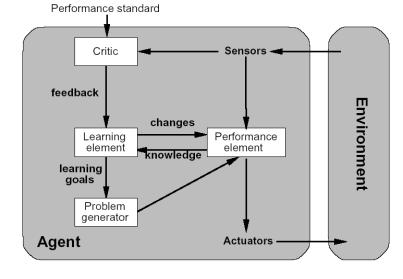Learning agents

When we expand our environments we get a larger and larger amount of tasks, eventually we are going to have a very large number of actions to pre-define. Another way of going about creating an agent is to get it to learn new actions as it goes about its business, this still requires some initial knowledge but cuts down on the programming greatly. This will allow the agent to work in environments that are unknown.
A learning agent can be split into the 4 parts shown in the diagram.
The learning element is responsible for improvements this can make a change to any of the knowledge components in the agents. One way of learning is to observe pairs of successive states in the percept sequence; from this the agent can learn how the world evolves. For utility based agents an external performance standard is needed to tell the critic if the agent’s action has a good or a bad effect on the world.
The performance element is responsible for selecting external actions, and this is considered to be the previous agents discussed.
The learning agent gains feedback from the critic on how well the agent is doing and determines how the performance element should be modified if at all to improve the agent.
For example when you were in school you would do a test and it would be marked the test is the critic. The teacher would mark the test and see what could be improved and instructs you how to do better next time, the teacher is the learning element and you are the performance element.
The last component is the problem generator, the performance generator only suggests actions that it can already do so we need a way of getting the agent to experience new situations, and this is what the performance generator is for. This way the agent keeps on learning.
For example coming back to the school analogy, in science with your current knowledge at that time you would not have thought of placing a mass on a spring but the teacher suggested an experiment and you did it and this taught you more and added to knowledge base.
Sources: (Artificial Intelligence: A Modern Approach by Stuart Russell and Peter Novig), Reference »